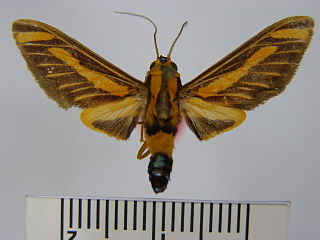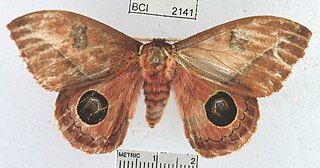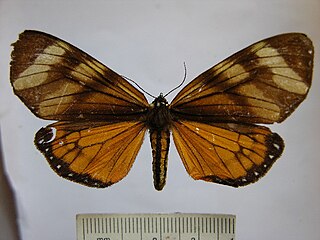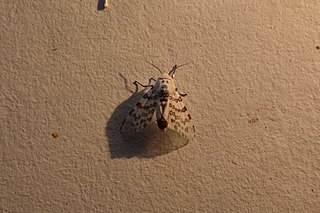
The genus Aellopos consists of large day-flying moths in the family Sphingidae. It was first described by Jacob Hübner in 1819. Species in this genus occur from Maine in the United States through Central America and down to Argentina and Uruguay in South America.

Eudocima is a genus of moths of the family Erebidae first described by Gustaf Johan Billberg in 1820.

Ophiusa tirhaca, the green drab, is a moth of the family Erebidae. The species was first described by Pieter Cramer in 1777. It is found in southern Europe, Africa, Australia and the southern parts of Asia.

Utetheisa lotrix, the salt-and-pepper moth or crotalaria moth, is a moth of the family Erebidae. The species was first described by Pieter Cramer in 1777. It is found in most of the Old World tropics.

Cephonodes picus is a moth of the family Sphingidae described by Pieter Cramer in 1777. It is found in most of the Old World tropics, including India, the Cocos-Keeling Islands, the Maldives, Papua New Guinea, the Philippines, the Torres Strait Islands, Brunei and the Chagos Archipelago.

Cacyparis is a genus of moths in the family Nolidae erected by Francis Walker in 1863. It is found in throughout India, Sri Lanka, Myanmar, Papua New Guinea and Australia.

Gonodonta sicheas is a moth of the family Erebidae first described by Pieter Cramer in 1777. It is found in Mexico, Guatemala, from Panama to Colombia, Venezuela, Ecuador, Peru, Brazil and on the Antilles. It is also found in the southern United States, including Florida and Texas.

Ormetica sypilus is a moth of the family Erebidae first described by Pieter Cramer in 1777. It is found in Suriname, Brazil, Ecuador and French Guiana.

Eucereon scyton is a moth of the subfamily Arctiinae first described by Pieter Cramer in 1777. It is found in Suriname and São Paulo, Brazil.

Pseudautomeris salmonea is a moth of the family Saturniidae first described by Pieter Cramer in 1777. It is found in Suriname, Panama, French Guiana, Venezuela, Brazil and Colombia.

Carales astur, the astur moth, is a moth of the family Erebidae. It was described by Pieter Cramer in 1777. It is found from Mexico to Bolivia and east to Suriname.

Dysschema eurocilia is a moth of the family Erebidae first described by Pieter Cramer in 1777. It is a common species throughout tropical America, where it has been recorded from the Antilles, Central America and South America.

Hypercompe icasia is a moth of the family Erebidae first described by Pieter Cramer in 1777. It is widely distributed in South America and is also found on Martinique, Guadeloupe, Saint Martin, Dominica, St. Kitts, Nevis, St. Thomas and Puerto Rico.

Hypocrita celadon is a moth of the family Erebidae. It was described by Pieter Cramer in 1777. It is found in Argentina, French Guiana, Suriname and Nicaragua.
Nyctemera cenis is a moth of the family Erebidae first described by Pieter Cramer in 1777. It is found in China, Taiwan, Japan, the north-western Himalayas, north-eastern India and Myanmar.
Pycnarmon diaphana is a moth in the family Crambidae. It was described by Pieter Cramer in 1777. It is found in Cameroon, the Democratic Republic of the Congo, Equatorial Guinea, Ethiopia, Seychelles, Sierra Leone, South Africa, Zambia, Zimbabwe, India and Sri Lanka.

Euploea eleusina, or Vollenhov's crow, is a butterfly in the family Nymphalidae. It was described by Pieter Cramer in 1777. It is found in the Indomalayan realm crossing the Wallace line to Sulawesi in the Australasian realm.














